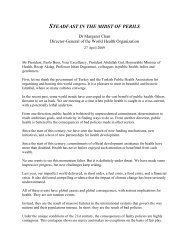The Evolution of HTA in Emerging Markets Health-Care ... - TREE
The Evolution of HTA in Emerging Markets Health-Care ... - TREE
The Evolution of HTA in Emerging Markets Health-Care ... - TREE
You also want an ePaper? Increase the reach of your titles
YUMPU automatically turns print PDFs into web optimized ePapers that Google loves.
OHE Consult<strong>in</strong>g Report for PhRMA<br />
5 January 2011<br />
-‐<br />
Consider country-‐specific evidence and issues <strong>in</strong> <strong>HTA</strong> <strong>in</strong> relation to the conceptual<br />
framework described earlier <strong>in</strong> Section 6;<br />
-‐<br />
-‐<br />
Critically assess the extent to which there are generalisable conclusions, i.e., lessons, about<br />
the role <strong>of</strong> <strong>HTA</strong> <strong>in</strong> emerg<strong>in</strong>g markets, and what the limits to those conclusions might be;<br />
Offer conclusions about how <strong>HTA</strong> might most usefully evolve <strong>in</strong> each system, and whether<br />
there are generalisable recommendations regard<strong>in</strong>g <strong>HTA</strong> <strong>in</strong> emerg<strong>in</strong>g markets.<br />
We can see from the Tables and from our analysis that the three countries can be categorised as<br />
follows with respect to level <strong>of</strong> spend and degree <strong>of</strong> centralisation.<br />
Level <strong>of</strong> spend<br />
In each <strong>of</strong> the three countries exam<strong>in</strong>ed <strong>in</strong> this report, their economic status as emerg<strong>in</strong>g markets is<br />
matched by, and reflected <strong>in</strong>, the development <strong>of</strong> their health systems to meet the grow<strong>in</strong>g<br />
expectations about and demands for health care and health.<br />
Brazil is spend<strong>in</strong>g around 8% <strong>of</strong> GDP on health as compared to 4% for Ch<strong>in</strong>a and 6% for Taiwan.<br />
Brazil is closest to the OECD average <strong>of</strong> 10% <strong>in</strong> 2008 (OECD <strong>Health</strong> Database, 2010). Ch<strong>in</strong>a is seek<strong>in</strong>g<br />
to <strong>in</strong>crease spend<strong>in</strong>g on health rapidly to around 6% <strong>of</strong> GDP.<br />
<strong>The</strong> development <strong>of</strong> health care systems <strong>in</strong> these economies comprises, with vary<strong>in</strong>g degrees <strong>of</strong><br />
speed and ambition, movements toward greater national coord<strong>in</strong>ation and consistency – i.e. a<br />
planned health system, emerg<strong>in</strong>g from the diverse, localised arrangements that characterise lesser<br />
developed countries. Especially <strong>in</strong> the larger emerg<strong>in</strong>g markets, such as Brazil and Ch<strong>in</strong>a, this process<br />
represents a very considerable challenge. In part, the evolution <strong>of</strong> health care systems <strong>in</strong> emerg<strong>in</strong>g<br />
markets (and the speed with which that takes place) reflects the pace <strong>of</strong> development <strong>of</strong> better<br />
<strong>in</strong>frastructure more generally <strong>in</strong> these economies.<br />
<strong>The</strong> rapid economic growth and development <strong>of</strong> these economies is, <strong>of</strong> course, also a facilitator for<br />
the development <strong>of</strong> the health care system: <strong>in</strong>dustrialisation leads to more economic activity be<strong>in</strong>g<br />
channelled <strong>in</strong>to the formal economy, <strong>in</strong>creas<strong>in</strong>g the potential tax base; and economic growth<br />
generates <strong>in</strong>creases <strong>in</strong> taxation revenue generated from any given tax base. Together these factors<br />
make it possible, <strong>in</strong> pr<strong>in</strong>ciple, to <strong>in</strong>crease the supply <strong>of</strong> collectively-‐funded health care and to reduce<br />
the reliance on out-‐<strong>of</strong>-‐pocket payments. Each <strong>of</strong> the three health care systems exam<strong>in</strong>ed <strong>in</strong> this<br />
report are, to some extent, work<strong>in</strong>g toward <strong>in</strong>creas<strong>in</strong>g universality -‐ that is, <strong>in</strong>creas<strong>in</strong>g the share <strong>of</strong><br />
the population covered by these schemes (although the start<strong>in</strong>g po<strong>in</strong>ts <strong>in</strong> each case are very<br />
different).<br />
Each is also struggl<strong>in</strong>g (<strong>in</strong> different ways) to reconcile rapidly ris<strong>in</strong>g expectations regard<strong>in</strong>g health<br />
care with what is currently available <strong>in</strong> health care terms given available budgets. <strong>HTA</strong> represents<br />
one means by which these tensions may be reconciled – although where, as appears to be the case<br />
<strong>in</strong> Brazil, limits on the resources to conduct the reviews result <strong>in</strong> substantial delays <strong>in</strong> access, which<br />
is unlikely to be a satisfactory response <strong>in</strong> the longer term.<br />
57








